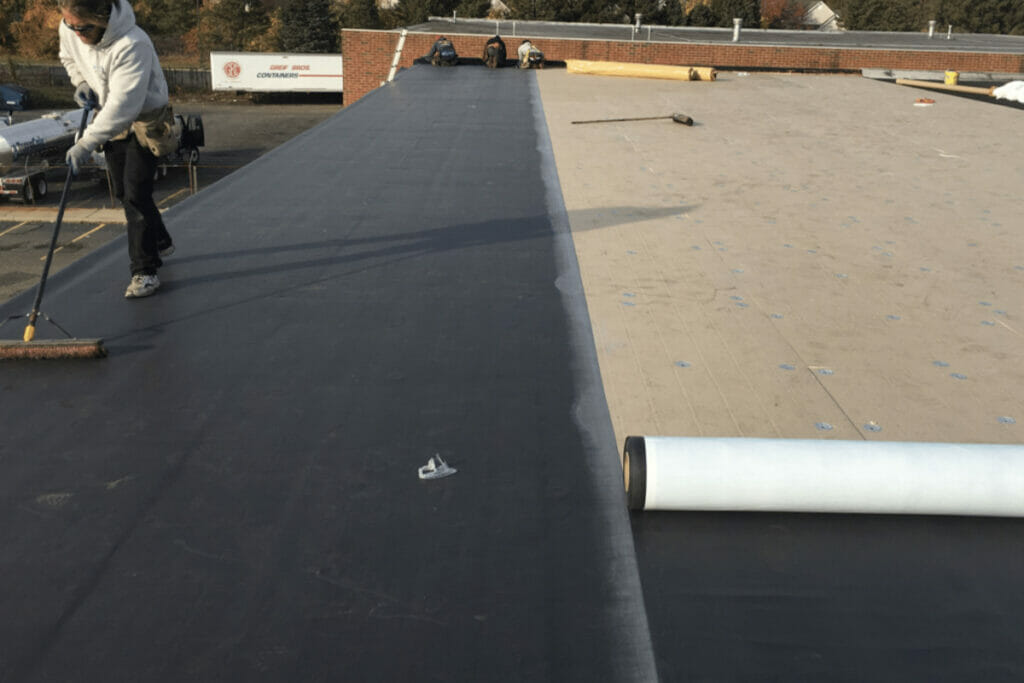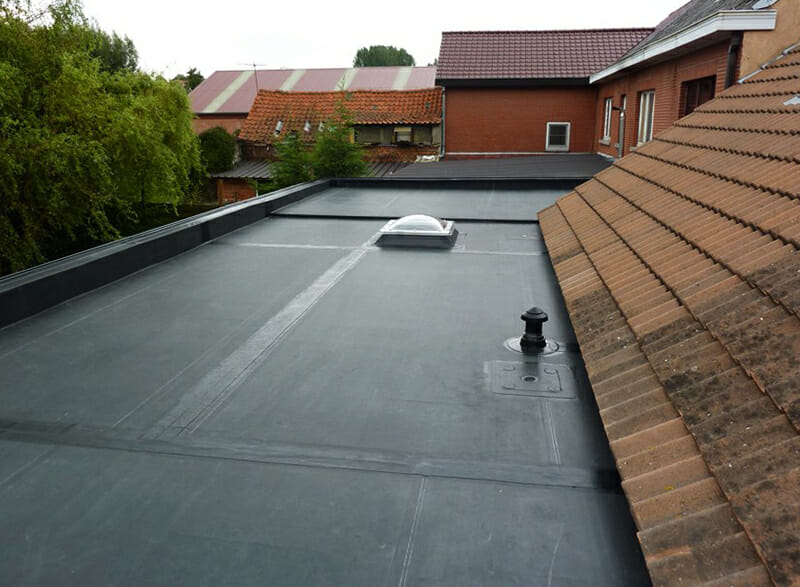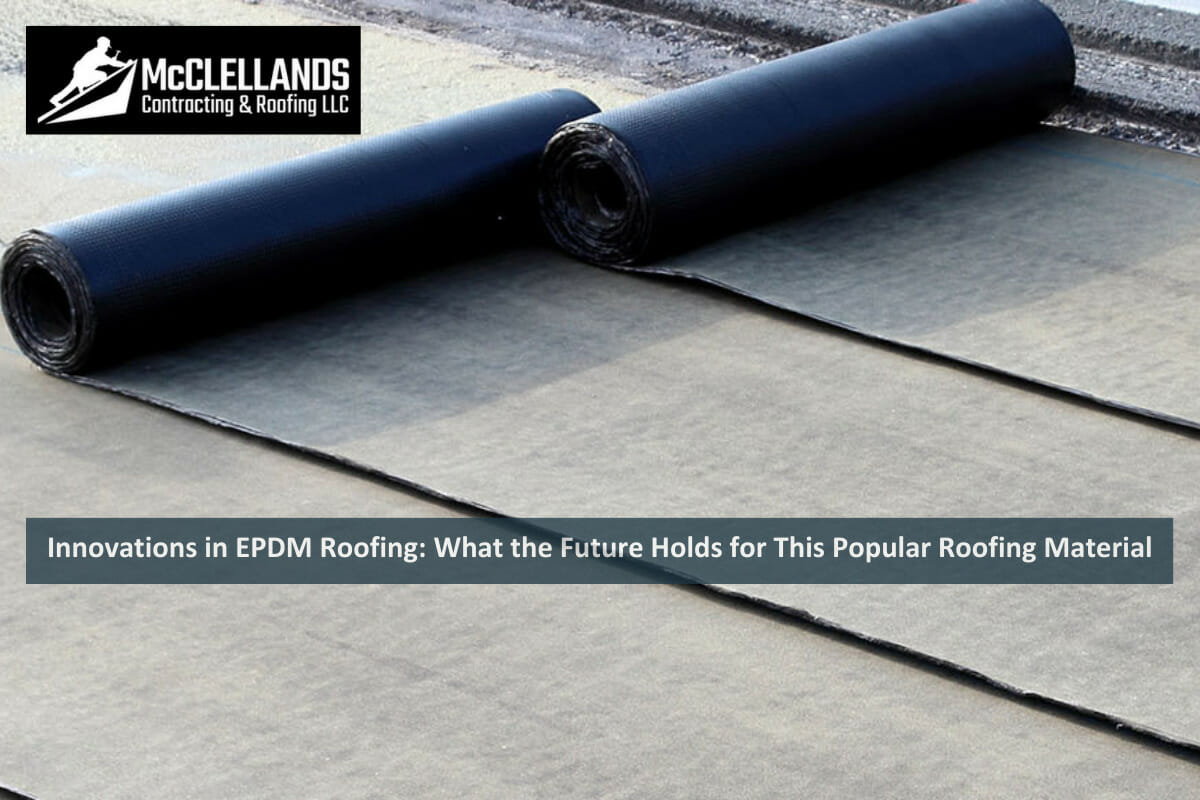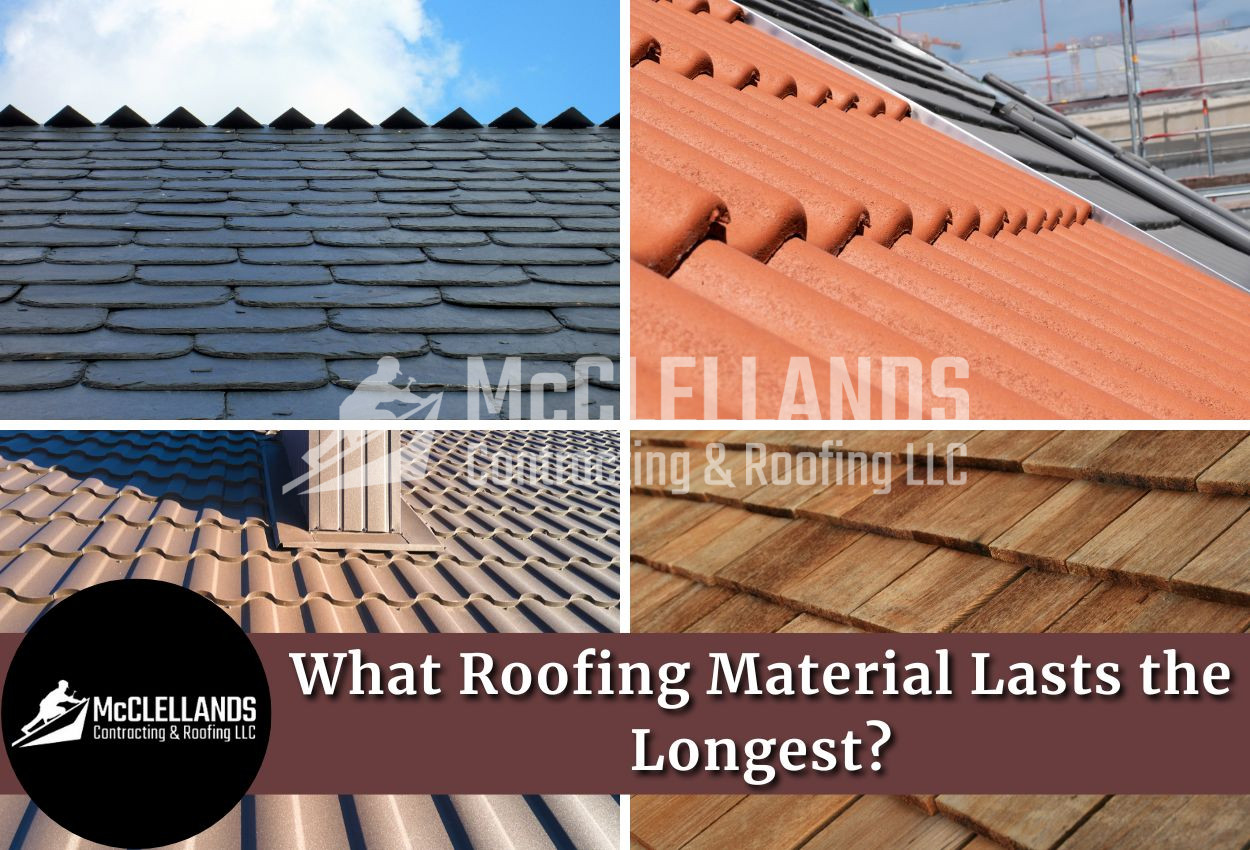EPDM roofing has been a popular choice for flat roofing applications for decades, all thanks to its durability, affordability, and ease of installation. However, as the roofing industry continues to evolve and adapt to the changing demands of consumers and the environment, it is only natural to wonder: what does the future hold for EPDM roofing?
With advancements in materials, manufacturing, and sustainability, the future of EPDM roofing is an exciting topic of discussion, especially when you are a homeowner with a flat roofing system. In this article, we will explore the innovations of EPDM roofing and predict what the future holds for this popular roofing material that owns a large market share in flashing.
But before we start with how EPDM has evolved and what the future holds, let us discuss what role EPDM plays in roofing.
What Is EPDM Roofing?
EPDM stands for Ethylene Propylene Diene Monomer, which is a synthetic rubber roofing material used for low-slope and flat roofs. EPDM roofing is made of a single-ply membrane that is extremely durable, weather-resistant, and long-lasting. It is commonly used for commercial buildings and industrial roofing applications due to its affordability and ease of installation. EPDM roofing has been in use since the 1960s and has become increasingly popular over the years due to its many advantages over other types of roofing materials.
A Widely Popular Synthetic Material
EPDM is not just limited to roofing applications. In fact, it has a wide range of uses across various industries. One of the most common uses of EPDM is in the automotive industry. EPDM is used to make weatherstripping, door seals, and other components that are designed to withstand exposure to harsh weather conditions.
History of the EPDM Rubber Roof
EPDM roofing has a relatively short history compared to other roofing materials such as slate, tile, or even asphalt shingles. EPDM was first developed in the 1960s by a team of researchers at the Monmouth Rubber and Plastics Corporation in New Jersey. Since then, EPDM roofs have gone through tremendous changes which we will cover later in this article.

Pros of EPDM Roofing
EPDM is amongst the most popular roofing membranes used for commercial and flat roofing applications. This is because the material has several advantages.
EPDM Is a Durable Material
What do you first look for in a roofing material? The answer to this is most likely going to be durability. An EPDM roof scores very well in this area. EPDM is highly durable and has a proven track record of lasting for over 30 to 40 years with proper maintenance. EPDM is resistant to extreme temperature fluctuations and weather conditions, including hail, and wind. It also offers high resistance to UV radiation and ozone, which causes other roofing materials to deteriorate over time.
EPDM Is a Low Maintenance Roofing Material
EPDM requires very little maintenance, which is a major advantage for property owners. As a business owner, you already have several things to take care of and you would not want to add to that stress by constantly worrying about maintaining your roof.
Unlike other roofing materials that require regular inspections or cleaning, EPDM roofing membranes only need occasional cleaning with water and mild detergent to keep them looking good. EPDM is also resistant to mold and mildew growth, which means it is less likely to become discolored or damaged by these issues.
If damage does occur to an EPDM roof, it is usually easy to repair with a special adhesive. Small punctures or tears can be fixed using a patch and adhesive, and larger damage can be repaired by replacing the affected section of the roofing membrane.
EPDM Is Cost Effective
EPDM roofs are generally considered to be more cost-effective than TPO. The material cost of EPDM roofing is typically lower than that of TPO roofing, and the installation process is often simpler and quicker, which can also reduce installation costs. Additionally, EPDM roofing is known for its long lifespan and low maintenance requirements, which saves property owners money in the long run by reducing repair and replacement costs.
Limitations of an EPDM Rubber Roofing System
Even the strongest of materials are not perfect. Every roofing material has limitations, whether it’s for a low slope roof or a pitched roof, or whether it’s a single-ply membrane or a built-up roof, and EPDM is no different. Here are some of its disadvantages:
Little to No Curb Appeal
Although curb appeal is usually not a top priority for flat roofs, as it is for pitched roofing, it still holds significance. EPDM rubber roofing systems have many characteristics, but they can lack a certain 'charm' when it comes to appearance.
EPDM is typically available in black or white, which can limit the design options, and may not be visually appealing to some property owners. While EPDM can be painted to match a building's color scheme, this is a costly and time-consuming process. However, if the color of your roofing system is not a primary concern then you can surely consider this material for your flat roof.
Prone To Punctures
EPDM roofing systems can be punctured by sharp objects such as tree branches, hail, or even foot traffic. While EPDM is highly resistant to tearing, punctures can still occur, especially during the installation process, or if the roof is exposed to debris or sharp objects. Punctures can lead to leaks, which cause significant damage to the roof and the interior of a building. It is important to regularly inspect and maintain an EPDM roof to identify and repair any punctures or other forms of damage to avoid costly repairs or replacements down the line.
Current State of EPDM Roofing
The roofing industry is constantly changing as manufacturers try to manufacture the best products for their customers. EPDM has also seen some changes over the years and is a lot better than it was when it was first introduced in the 60s.
In recent years, there have been several exciting developments in EPDM roofing materials that have enhanced the durability, weather resistance, and energy efficiency of these roofs.
More Sustainable Than Ever!
In terms of sustainability, EPDM roofs have made significant advancements in recent years. EPDM is already known for its long lifespan and recyclability, but new developments in manufacturing have allowed for the creation of EPDM roofing materials that are even more environmentally friendly. With each passing year, environmental concerns are constantly increasing. Amongst these concerns, homeowners are looking for ways in which they can contribute to the environment and sustainability.
Luckily, EPDM rubber roofs can ease these concerns. This single-ply membrane has gone through several changes and now can be recycled with ease. For example, some manufacturers are producing EPDM roofing materials that contain up to 30% post-consumer recycled materials, reducing waste and the need for new resources.
Increased Energy Efficiency
This feature has also witnessed a change. Over the years, there were some concerns about EPDM’s energy efficiency as it was only available in a black color that tended to have low reflectivity, and therefore, attracted more sunlight and UV radiation.
Now these roofs are no longer restricted to just black EPDM sheets. Due to the rise of several flat roof coatings made specifically for rubber roofs, EPDM membranes can now be painted with a lighter color that reflects more sunlight and reduces heat absorption. In fact, white EPDM is quite popular as it uses titanium dioxide for its bright white color. This results in lower cooling costs for a building and reduces the strain on HVAC systems, leading to energy savings and a smaller environmental impact.
EPDM Is Now Used for Residential Properties As Well
Due to its many benefits, such as its durability, ease of installation, and low maintenance requirements, EPDM roofing now has an increased scope.
EPDM has traditionally been used for commercial roofing applications, but in recent years, it has also gained popularity in residential roofing as well. The roof replacement process for EPDM does not take much time, which is helpful as it won’t interfere with your busy schedule.
As highlighted in the section on advantages above, EPDM is an excellent option for residential flat roofs. It provides a seamless and waterproof barrier capable of withstanding harsh weather conditions, such as high winds, heavy rain, and snow, which are common in cities across Pennsylvania.
You Can Install Roof Accessories
EPDM roofing systems are compatible with the installation of solar panels and other accessories. In fact, EPDM is often the preferred roofing material for solar panel installation due to its durability and ability to provide a watertight seal. Other accessories, such as roof hatches, skylights, and HVAC units, can also be installed on EPDM roofs with the proper attachment methods.
Better Resistance to Puncturing
One of the issues with EPDM is that it is easily punctured, but this problem has been dealt with in the last few years. The introduction of the 90-mil sheet, which is the latest in the industry, has been praised all over for its puncture resistance.

EPDM Roofing Material: What’s in Store for the Future?
Despite its relatively recent introduction to the roofing industry compared to traditional roofing methods, EPDM has rapidly gained popularity and trust amongst contractors and homeowners alike. With the rubber roof getting better each year, what will be its future? Will it gain more attention?
The future of EPDM roofing technology looks promising, with continued advancements in durability, energy efficiency, and sustainability.
Improved Strength
Another trend is the development of increasingly durable EPDM roofing materials, which can withstand extreme weather conditions and outlast traditional EPDM roofing. In the past, EPDM roofs had a lifespan of 20 to 25 years, but now, many can last for over 35 to 40 years. New manufacturing techniques, such as the incorporation of high-strength polymers, further enhance the strength and durability of EPDM roofing systems. This makes it even more reliable for use on a broader range of buildings and climates
More Use of Technology in Roof Inspection and Installation
Technology continues to advance at a rapid pace, even in the roofing industry.
It is expected that the use of new technology will increase in the future. One example of this is the use of drones to conduct roof inspections. Roofers now use drones with high-resolution cameras. This allows contractors to inspect a roof safely and identify potential issues before they become more significant.
This advancement not only improves safety on job sites by eliminating the need for manual inspections, but it also increases efficiency and reduces the amount of time required to complete the project. We also expect more improvements in the installation method of EPDM too.
Overall, the future of EPDM looks promising, with continued advancements in durability, energy efficiency, and sustainability. As the roofing industry and building owners become more environmentally conscious, EPDM roofing is sure to play an increasingly important role in meeting these demands and promoting sustainable building practices.
Need an EPDM Roof? We Can Help
As we have seen, an EPDM roofing system not only boasts a solid present popularity, but also a promising future. It offers strength, flexibility, and durability, which is everything you want from a flat roofing membrane. However, deciding to install a new EPDM roof is not enough, you also need a professional roofing contractor to install it like the team at McClellands Contracting and Roofing.
We are the best roofing company in Pittsburgh, Pennsylvania, and have been offering flat roof installation services in the area for years. We install high-quality EPDM roofs and several types of roof coatings so that you can be assured that your flat roof stays well protected.
Don't let an average handyman misguide you, contact us today at (412) 353-5660 and take the first step towards having a great roof.




